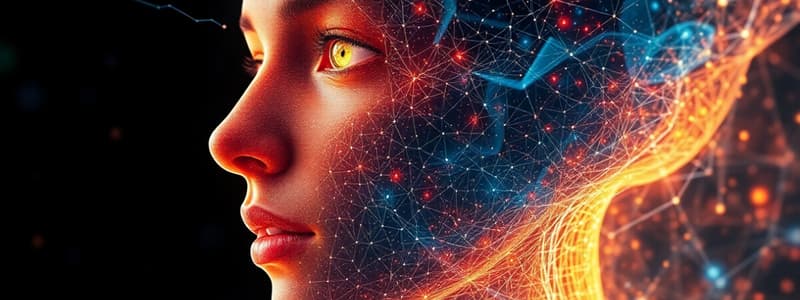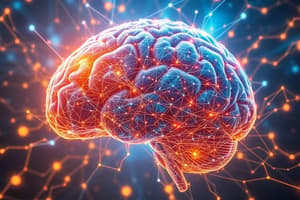Podcast
Questions and Answers
What specific neurological evidence distinguishes prosopagnosia from other conditions affecting face recognition?
What specific neurological evidence distinguishes prosopagnosia from other conditions affecting face recognition?
- Impaired emotion recognition
- Impaired expression recognition
- Intact identity recognition (correct)
- Distorted visual perception of faces
What does fMRI reveal about infants aged 2-9 months regarding face-selective responses?
What does fMRI reveal about infants aged 2-9 months regarding face-selective responses?
- They demonstrate face-selective responses in adult-like regions (correct)
- Their responses are identical to congenital blind individuals
- They lack face-selective regions until one year old
- They respond exclusively to body stimuli
What is a common characteristic of Capgras' syndrome?
What is a common characteristic of Capgras' syndrome?
- Belief that familiar faces are replaced by impostors (correct)
- Inability to recognize any emotional expressions
- Complete visual agnosia and inability to perceive faces
- Impaired identity recognition and emotion recognition
What does the activation of face brain areas in congenitally blind individuals suggest?
What does the activation of face brain areas in congenitally blind individuals suggest?
What are Event-Related Potentials (ERPs) primarily used for in the context of EEG studies?
What are Event-Related Potentials (ERPs) primarily used for in the context of EEG studies?
Which area is primarily responsible for the early perception of facial features?
Which area is primarily responsible for the early perception of facial features?
What is a primary function of the Fusiform Face Area (FFA)?
What is a primary function of the Fusiform Face Area (FFA)?
Which model of face perception suggests that invariant and variant features are processed by separate modules?
Which model of face perception suggests that invariant and variant features are processed by separate modules?
What distinctive feature is associated with fMRI studies related to face processing?
What distinctive feature is associated with fMRI studies related to face processing?
Which statement correctly describes a neural model of face perception?
Which statement correctly describes a neural model of face perception?
What is the N170 primarily associated with in terms of perceptual processing?
What is the N170 primarily associated with in terms of perceptual processing?
In prosopagnosia, which N170 effect is specifically absent?
In prosopagnosia, which N170 effect is specifically absent?
What effect does TMS over the right occipital face area (OFA) have on early facial processing?
What effect does TMS over the right occipital face area (OFA) have on early facial processing?
What is a limitation of TMS that differentiates it from fMRI?
What is a limitation of TMS that differentiates it from fMRI?
What potential role does the OFA play in the processing of faces?
What potential role does the OFA play in the processing of faces?
Which brain area is notably not reachable by TMS according to the information provided?
Which brain area is notably not reachable by TMS according to the information provided?
The expression and identity recognition routes may separate at which stage of processing?
The expression and identity recognition routes may separate at which stage of processing?
Which factor influences the degree of impairment in emotion recognition for those with prosopagnosia?
Which factor influences the degree of impairment in emotion recognition for those with prosopagnosia?
What effect does fatigue have on the N170 response?
What effect does fatigue have on the N170 response?
During what time period does inhibition of the pSTS affect expression matching?
During what time period does inhibition of the pSTS affect expression matching?
Flashcards
Prosopagnosia (Face Blindness)
Prosopagnosia (Face Blindness)
A neurological condition that affects an individual's ability to recognize familiar faces, even close family members.
Fusiform Face Area (FFA)
Fusiform Face Area (FFA)
The brain area responsible for processing facial information, located in the fusiform gyrus.
Parahippocampal Place Area (PPA)
Parahippocampal Place Area (PPA)
The region responsible for processing scenes and locations, located near the FFA.
Extrastriate Body Area (EBA)
Extrastriate Body Area (EBA)
Signup and view all the flashcards
Capgras Syndrome
Capgras Syndrome
Signup and view all the flashcards
Occipital Face Area (OFA)
Occipital Face Area (OFA)
Signup and view all the flashcards
Superior Temporal Sulcus (STS)
Superior Temporal Sulcus (STS)
Signup and view all the flashcards
Repetition Suppression
Repetition Suppression
Signup and view all the flashcards
Bruce & Young Model
Bruce & Young Model
Signup and view all the flashcards
N170
N170
Signup and view all the flashcards
Transcranial Magnetic Stimulation (TMS)
Transcranial Magnetic Stimulation (TMS)
Signup and view all the flashcards
Prosopagnosia
Prosopagnosia
Signup and view all the flashcards
N170 effect in prosopagnosia
N170 effect in prosopagnosia
Signup and view all the flashcards
N170 inversion effect in prosopagnosia
N170 inversion effect in prosopagnosia
Signup and view all the flashcards
Role of OFA in facial expression processing (TMS)
Role of OFA in facial expression processing (TMS)
Signup and view all the flashcards
Role of pSTS in facial expression processing (TMS)
Role of pSTS in facial expression processing (TMS)
Signup and view all the flashcards
Role of FFA in facial identity processing (TMS)
Role of FFA in facial identity processing (TMS)
Signup and view all the flashcards
Study Notes
Perceiving Faces and Bodies
- Processing facial and bodily information is essential for recognizing friends, colleagues, and understanding others' emotions and intentions.
Perceiving Faces
- Faces convey a wealth of information.
- Invariant features: Identity, age, sex/gender, ethnicity, attractiveness, trustworthiness, and health.
- Variant features: Emotion, focus of attention, and intentions (speech-related movements).
- Neural Basis: A vast neural network encompasses cortical and subcortical areas.
- Some areas in the back of the head (e.g., core network) are crucial for face processing.
Occipital Face Area (OFA) and Fusiform Face Area (FFA)
- OFA: Specialized in early perception of facial features.
- FFA: Specialized in processing facial identity.
- Nancy Kanwisher contributed significantly to the discovery of FFA.
- fMRI and repetition suppression studies show neural activity decreases when identical stimuli are repeated.
fMRI and Repetition Suppression
- Neural activity decreases when identical stimuli are repeated.
Models of Face Perception
- Face processing has a rich history in psychology.
- Early models were primarily cognitive (boxes and arrows).
- More recent models are inspired by neuroscience, mainly due to advances in brain imaging.
- Bruce & Young (1986) developed a cognitive model of face perception.
Structural Encoding
- Detects individual features (e.g., eyes, nose) in a specific configuration.
- Invariant features (e.g., identity) and variant features (e.g., emotional expressions) are processed separately.
- Mutual exchange between face processing modules and the cognitive system.
- Haxby et al. (2000) developed a neural model extending Bruce & Young (1986).
- Includes variant vs. invariant aspects and core vs. extended systems.
Evidence of Models
- Dissociation between facial identity and expression supported by neurological patients, brain imaging, and intracranial recordings of non-human primates.
- Neurological evidence for dissociation of face identity and expression (e.g., N170).
- Evidence from transcranial magnetic stimulation (TMS).
- fMRI shows face-selective regions in adults and infants (Deen et al., 2017).
- fMRI shows activation of face brain areas in congenitally blind people touching faces, suggesting that visual experience isn't solely required for face-recognition neuron development (Ratan Murti et al., 2020)
Prosopagnosia (Face Blindness)
- A neurological condition affecting the reliable recognition of familiar faces.
- Typically, intact emotion recognition, but ventral occipito-temporal lesion (acquired prosopagnosia).
- Capgras syndrome: belief that close others have been replaced by impostors, while retaining identity recognition.
Event-Related Potentials (ERPs)
- ERPs are averaged EEG responses.
- The N170 is a negative-polarity ERP component elicited by faces, larger for faces compared to other objects, occurring over the occipito-temporal area.
- This is thought to reflect either the structural or perceptual aspects of face processing, and is also linked to prosopagnosia
- Anomalous or absent N170 effect in acquired or developmental prosopagnosia.
TMS Evidence
- TMS (transcranial magnetic stimulation) provides direct evidence on a brain area's role in a cognitive process (unlike fMRI).
- Temporarily inhibits neural activity in targeted brain areas.
Inhibition of OFA and pSTS
- OFA inhibition disrupts expression matching (60-100 ms).
- pSTS inhibition disrupts expression matching over a longer time period (60-140 ms).
Emotional Expression Processing - Additional Players
- Amygdala and somatosensory cortices play crucial roles.
- Facial feedback hypothesis: Facial expressions not only communicate emotions but also influence them.
- Mimicry: People tend to imitate perceived emotional facial expressions.
- Blocking facial mimicry interferes with emotion recognition.
Role of Somatosensory Cortices
- Internal mimicry (imagining facial expressions) is hypothesized to be critical in recognizing facial emotions.
- Blocking somatosensory cortex function via TMS affects emotion recognition.
- Blocking/interfering with facial mimicry affects emotion recognition.
Face Perception Study
- Core areas for face processing are in the back of the brain.
- OFA (facial features).
- FFA (facial identity).
- STS (facial expressions, gaze).
Perceiving Bodies
- Bodies also convey information.
- We use this information every day. (E.g., to identify, recognize emotions, discern mood, age, sex, attractiveness, and health).
Extrastriate Body Area (EBA)
- High response to human body parts and whole bodies.
- More holistic body representation than the FFA for faces.
N190 ERP Component
- Peaks after N170 (20ms later), larger for bodily stimuli than faces or other objects.
- The N190 component generalizes to abstract depictions of the body (stick figures), and increases for inverted bodies.
Inhibition of EBA with TMS
- Implanted electrodes over EBA show greater responses to images of bodies than faces, objects, or animals.
- Body-selective responses start around 190 ms.
- TMS inhibition affects the perception of biological motion (e.g., human point light displays).
Fusiform Body Area (FBA)
- Responds selectively to whole bodies, body parts, and schematic depictions.
- Creates a holistic body representation compared to the EBA.
Summary - Body Perception
- EBA responds to body parts and wholes.
- FBA more selective for holistic body representations.
- STS processes body movement.
- Similar organization to faces: Face identity/emotion in FFA and STS.
- Emotional body language (EBL) exists.
Summary - Face and Body Perception
- Core face network includes OFA (features), FFA (identity), and STS (expressions, gaze).
- Core body network encompasses EBA (parts), FBA (holistic), and STS (movements).
Fast Integration of Emotion in Faces and Bodies
- Facial emotion perception can be influenced by body emotion.
- Incongruent face-body pairings lead to lower accuracy.
- Faces and bodies are initially processed separately in the posterior brain areas, then integrated in more anterior areas.
Studying That Suits You
Use AI to generate personalized quizzes and flashcards to suit your learning preferences.



